Essential Nesting Materials for Healthy Parakeets
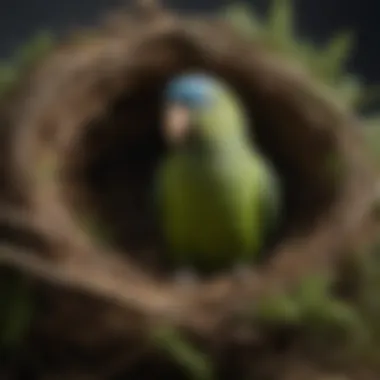

Intro
Nesting material plays a critical role in the reproductive health and overall well-being of parakeets. Understanding the various options available can significantly affect their comfort and safety. Pet owners need to be informed about the importance of appropriate nesting materials. Choosing the right type ensures that parakeets can breed successfully while also feeling secure in their environment. This article delves into various nesting materials, offering guidance on the benefits and drawbacks of each type, preparation methods, and other essential health and safety considerations.
Understanding Your Pet
Before we discuss nesting material, it is essential to comprehend the behavior and needs of parakeets.
Pet Behavior Basics
Parakeets are social creatures. They thrive in an environment where they can express their natural behaviors. In the wild, they create nests to ensure safety and comfort during breeding. Understanding these instincts will guide pet owners in providing suitable nesting materials that cater to these behaviors.
Common Breed Characteristics
Different breeds of parakeets may exhibit unique nesting preferences. For instance, budgerigars often appreciate more concealed spaces, while other breeds might prefer open nests. Recognizing these traits is useful for selecting appropriate materials.
Species-Specific Needs
Parakeets require specific nesting environments to ensure their psychological well-being. This can range from small nesting boxes to natural plant materials. Identifying these species-specific needs helps in creating a nurturing environment.
Choosing Nesting Materials
Types of Nesting Materials
There are several types of nesting materials available for parakeets. Each has its pros and cons:
- Natural Grass: Excellent for insulation but can carry pests.
- Sisal Fiber: Durable but can be harsh on sensitive feet.
- Paper: Easy to manipulate but can tear easily in larger nests.
- Coconut Fiber: Absorbent and comfortable, yet it may harbor mold if not dried properly.
"Choosing the right nesting material is not just about comfort; it is about safety and health of your parakeets."
Preparation Techniques
Preparing nesting materials requires care. Here are some simple methods:
- Cleaning: Ensure all materials are clean and free from chemicals.
- Drying: Dry organic materials well to prevent mold growth.
- Shredding: For paper or soft materials, shredding helps create a cozy spot.
Health and Safety Considerations
When selecting nesting materials, be aware of health risks. Avoid materials that contain chemicals or toxins. Assess whether the material can harbor bacteria or parasites. Always prioritize your parakeet’s health.
Ending
An understanding of nesting materials for parakeets is vital for their well-being. As pet owners, providing the best options fosters a healthy breeding environment. Adequate knowledge about materials, their preparation, and safety considerations empowers owners to make informed decisions.
Prelude to Parakeet Nesting Needs
Nesting is a crucial aspect of the breeding behavior exhibited by parakeets. Understanding the right materials and methods to provide suitable nesting options is essential for their health and well-being. Adequate nesting setups play a role in ensuring the comfort and security of the parakeets during their breeding season. When pet owners observe their birds' nesting behaviors closely, they can appreciate the intricate needs of these creatures.
Importance of Nesting Materials
Nesting materials serve multiple functions for parakeets. They not only help create a physical space that allows for laying eggs but also contribute to the psychological comfort of the birds. Proper nesting environments can reduce stress, resulting in healthier offspring and strong bonding between mates. Materials should be safe, comfortable, and mimic what parakeets would seek in the wild. Common materials like grasses, twigs, and even paper can play significant roles in successfully satisfying these needs.
The choice of nesting material can also influence the overall behavior of parakeets. For instance, some materials may encourage natural preening and nest-building behaviors. This engagement is vital for the birds as it keeps them active and mentally stimulated. Importantly, the quality and type of materials used directly affect the hygiene and safety of the nesting site, which is pivotal for the health of the parakeets.
Natural Instincts in Breeding
Parakeets, like many birds, are driven by instinct when it comes to breeding. In their natural environment, they seek specific materials to construct nests that offer protection and comfort. This instinctual behavior doesn't dissipate in captivity. Therefore, pet owners need to provide a nesting environment that mimics these natural conditions.
Parakeets will often start to gather materials on their own if provided with the opportunity. They may use materials such as dried grass or even feathers they shed. This behavior is not just about creating a nest; it is essential for their reproductive success. By nesting, they create a space where the female can lay eggs safely, fostering a secure environment for raising young birds. Understanding this instinct helps pet owners support their parakeets in a way that aligns with their natural behaviors.
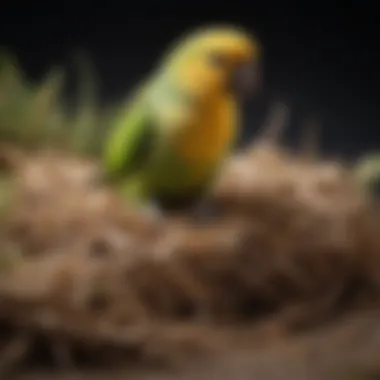
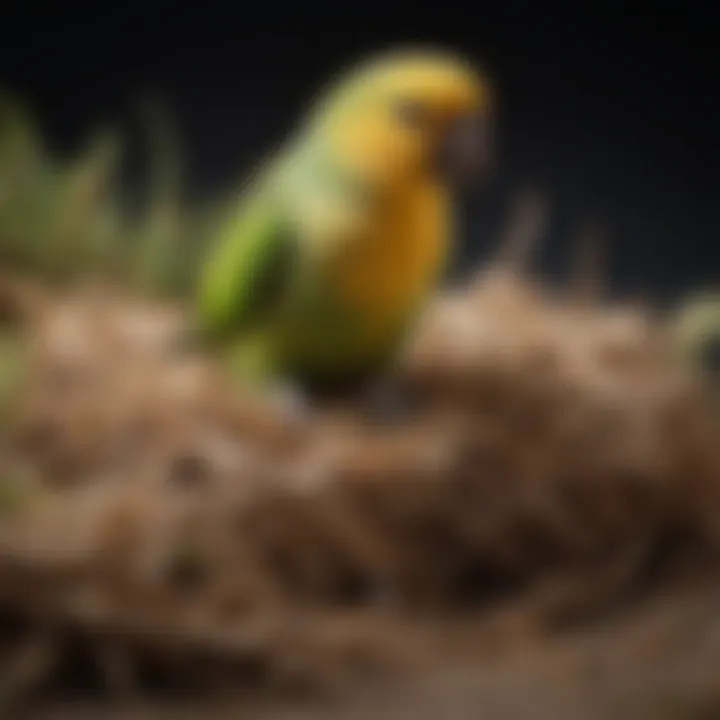
Types of Nesting Materials
Nesting materials play a critical role in creating a safe and comfortable environment for parakeets, particularly during the breeding season. The right materials provide necessary comfort and security for the birds. Different types of nesting materials can influence the breeding process and the overall well-being of parakeets. Choosing appropriate nesting materials ensures that they can express their natural behavior while creating a suitable habitat for raising their young.
Understanding the various types of nesting materials available allows pet owners to make informed decisions. It is essential to evaluate the benefits and drawbacks of each option to find what is best for specific circumstances and parakeet species. Thus, a detailed look into common nesting materials provides a foundation for fostering the health and happiness of these birds.
Grass and Straw
Grass and straw represent traditional choices for nesting materials among many bird owners. This natural option offers several advantages. Grass, when harvested properly, remains free from contaminants and pesticides, ensuring its safety for parakeets. Its fibrous texture allows birds to mold it according to their preferences. Moreover, straw is accessible and cost-effective, often coming from suppliers focusing on agricultural byproducts.
Despite its benefits, there are considerations. Grass and straw can carry allergens or bacteria, so it is important to regularly check for signs of mold. Choosing clean sources minimizes these risks. Additionally, while grass is pliable, straw may not provide the same warmth, particularly in colder climates.
Wood Shavings
Wood shavings are another popular nesting material. They tend to absorb moisture well, keeping the nest relatively dry. This quality helps maintain a healthy environment for breeding. Wood shavings are lightweight and easy to manipulate, allowing parakeets to shape their nesting area. Furthermore, the natural aroma of wood can be soothing for the birds.
However, there are also drawbacks. Not all wood shavings are safe; for instance, those made from cedar or pine can be harmful due to aromatic oils. Pet owners should select shavings from safe species such as aspen. Always confirm the source to ensure that the product is free from additives or toxic treatments.
Paper Products
Paper products are an increasingly popular choice. They offer flexibility and are easily accessible. Recycled paper and tissue products are popular because they can be soft and easy for birds to handle. These materials can also be shredded into smaller pieces, allowing parakeets to design nests to their liking.
On the downside, paper products may not have the same absorbent qualities as wood shavings or grass. If a wet environment occurs, these materials can deteriorate quickly. Regular replacements are necessary to ensure cleanliness, reducing the risk of bacteria or mold growth.
Sisal and Natural Fibers
Sisal and other natural fibers are useful options for nesting materials, especially for parakeets that enjoy manipulating their environment. These materials provide texture and can withstand chewing—an important feature as parakeets often interact with their nesting area. Sisal, in particular, has good durability and is less likely to harbor mold compared to damp materials.
Nevertheless, sisal can present some dangers if not sourced correctly. Some products may be dyed or treated with chemicals. Select natural and untreated fibers to avoid exposing birds to harmful substances. While sisal is excellent for texture, ensure it is combined with other materials for warmth and comfort.
In summary, the selection of nesting materials shapes parakeets' experiences. By understanding the various types of materials available, pet owners can better provide for the needs of their birds.
Evaluating Nesting Materials
When considering nesting materials for parakeets, evaluation is essential. This process helps pet owners understand the strengths and weaknesses of various materials. Ultimately, selecting the right nesting material impacts a parakeet's comfort, safety, and breeding behavior. Knowing how to evaluate these materials can lead to a healthier and happier bird, which is the primary goal of responsible pet care.
Pros and Cons of Common Materials
Each nesting material brings its own set of advantages and disadvantages. Understanding these can aid in making informed decisions.
- Grass and Straw
Pros: Natural texture, promotes instincts, and easy to find.
Cons: Can harbor pests or mold if not maintained properly. - Wood Shavings
Pros: Absorbs moisture, provides insulation, and is easy to clean.
Cons: Some woods, like cedar, can be toxic to birds. - Paper Products
Pros: Readily available, inexpensive, and easy to recycle.
Cons: Lacks insulation properties and may not feel natural to birds. - Sisal and Natural Fibers
Pros: Strong and durable, provides a natural feel, and supports chewing behavior.
Cons: May be difficult to find and potentially pricey compared to other options.
Evaluating these materials carefully can prevent potential health hazards and support parakeet breeding behaviors effectively.
Suitability for Different Parakeet Species
Parakeet species vary in size, temperament, and breeding habits. Knowing this will help tailor the nesting materials to specific needs. For instance,
- Budgerigars: Generally require softer materials for comfort. Grass or paper products may be best.
- Cockatiels: As they are larger, wood shavings or sisal may provide better support.
The choice of nesting materials can significantly influence breeding success and overall welfare. Always consider the unique traits of your parakeet species when evaluating options.
Preparing Nesting Materials
In caring for parakeets, preparing nesting materials is a fundamental task. It requires careful thought and attention to detail. Quality nesting materials support the health and comfort of these birds during their breeding periods. Properly prepared materials can enhance the overall environment of the aviary, making it a nurturing space for both the parents and their future hatchlings.
This section focuses on two main aspects of preparation: cleaning and sterilization of nesting materials and the arrangement of the nesting areas. Each step has its significance, directly influencing the well-being of the birds.
Cleaning and Sterilization
Ensuring that nesting materials are clean and sterilized is crucial. Birds are vulnerable to various pathogens, and introducing unclean materials into their living area may lead to infections.
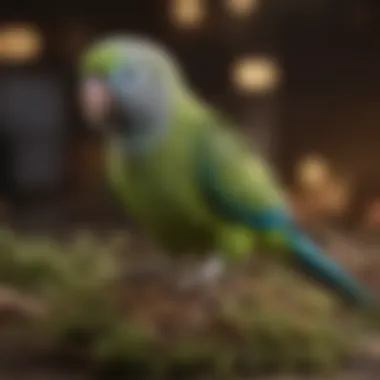
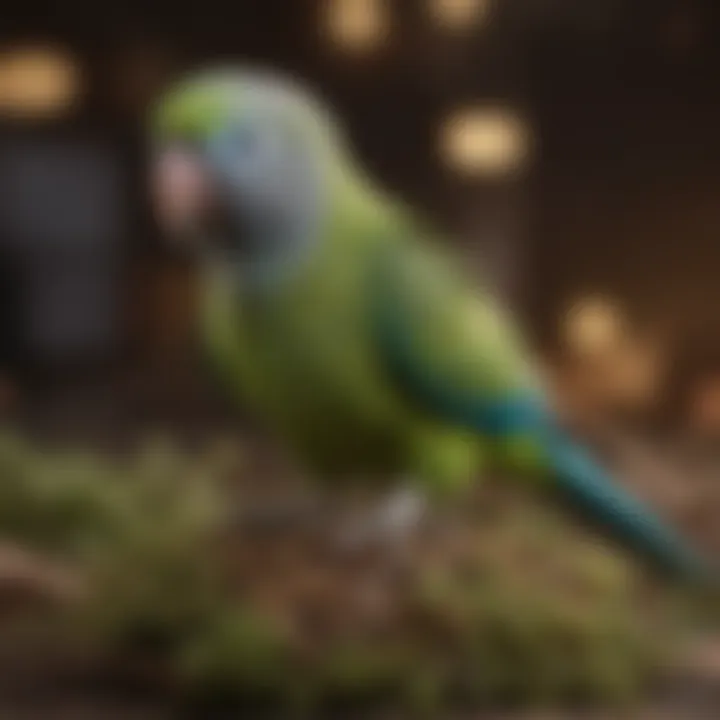
- Source of Materials: Always select materials that are free from chemicals or pesticides. If you gather natural items, inspect them closely before use. Any sign of decay or contamination should disqualify them.
- Cleaning Process: Use warm water and a safe soap to wash any synthetic products. Rinse thoroughly to avoid any residues. For natural materials like grass or straw, shaking off dust and debris is usually enough, sometimes followed by a gentle rinse.
- Sterilization: After cleaning, consider sterilizing materials. One method is to place them in boiling water for a few minutes. This kills off most pathogens that could be harmful to the birds. Another option is to use a solution of diluted bleach, but it must be thoroughly rinsed to ensure no chemicals linger.
By following these steps, pet owners can significantly lower the risk of health issues related to nesting materials.
Arranging Nesting Areas
After ensuring the cleanliness and safety of the materials, the next step is arranging the nesting areas effectively. An ideal setup considers several factors, including space, privacy, and accessibility for the parakeets.
- Space Allocation: Make sure that the nesting box reflects the species-specific needs of the parakeets. For example, Budgerigars often prefer smaller, more enclosed spaces while other species may need larger areas. Avoid overcrowding as this can cause stress.
- Privacy: Parakeets require privacy to feel secure while nesting. Place nests in quieter parts of the aviary. Shield them from excessive movement and noise to create a calm atmosphere.
- Accessibility: Parakeets need easy access to the nesting areas. Ensure the entrance to the nesting box is not blocked and that there are suitable perches nearby. This encourages the birds to explore and utilize the nesting space.
The careful arrangement of nesting areas goes a long way in fostering a secure environment for breeding. Properly prepared nesting materials and well-planned nesting areas significantly enhance the parakeets' experience during this crucial time in their life cycle.
"A well-thought-out nesting area can significantly impact the breeding success of parakeets."
In summary, preparing nesting materials consists of two fundamental elements: cleaning and sterilization and arranging nesting areas. Both aspects contribute to effective bird care, ensuring that parakeets are healthy and comfortable while nesting.
Health Considerations
When selecting nesting materials for parakeets, health considerations emerge as a crucial aspect that cannot be overlooked. The right nesting material does not only promote the comfort of these birds but also plays a significant role in their overall health and well-being. Improper choices could lead to serious health issues. Thus, understanding the potential risks associated with nesting materials ensures that parakeets have a safe environment to breed and raise their young.
Avoiding Toxic Materials
Toxic materials pose a significant threat to parakeets. Some common items may seem harmless but can lead to serious health complications. Owners should be vigilant when choosing materials to ensure they are free from harmful substances.
- Chemicals: Certain chemicals, often found in processed materials, can be toxic. For instance, materials that are treated with pesticides or dyes should be avoided.
- Wood: Some types of wood, like cedar or treated lumber, contain oils or chemicals that can be harmful to birds. Instead, opt for safe woods such as untreated pine or birch.
- Processed Products: Materials like synthetic fibers may release harmful particles when shredded. It’s best to stick with natural, unprocessed options.
Owners can create a safer environment by always checking the source and quality of nesting materials. Researching reputable brands that cater to pet care can help in making informed decisions. The emphasis here should be on safety, as parakeets will often chew or ingest anything in their environment.
Important Note: Always consult with avian veterinarians when in doubt about the safety of materials for parakeets.
Prevention of Mold and Bacteria
Mold and bacteria can thrive in damp or unclean environments, putting parakeets at risk for various infections. Ensuring that nest materials are kept clean and dry is essential for the health of the birds.
- Regular Inspections: Occasionally check the nesting area for signs of moisture or decay. This practice helps catch issues before they escalate.
- Proper Drying: Any natural materials should be thoroughly dried before introducing them into the nest. This reduces the risk of mold growth significantly.
- Cleaning: Routine cleaning of the nesting area can help minimize bacteria. Use non-toxic cleaners to ensure that no harmful residues are left behind.
By paying close attention to these elements, pet owners can create a nurturing and healthy environment for their parakeets. The benefits of prevention far outweigh the troubles caused by neglecting these crucial factors.
Maintaining appropriate health standards in nesting materials will support parakeets in achieving a healthy and joyful life.
Environmental Factors
Understanding the environmental factors that impact parakeets' nesting habits is essential for their well-being. These factors not only influence the choice of nesting materials but also significantly affect the overall health and comfort of the birds. Creating an ideal environment for nesting is critical, especially when it comes to breeding.
Key elements of the environment to consider include climate, placement within the aviary, and the overall habitat provided. Each aspect plays a vital role in the comfort level of parakeets. By focusing on these environmental factors, pet owners can enhance their breeding success and ensure a healthy lifestyle for their winged companions.
Climate Considerations
Climate plays a pivotal role in the nesting habits of parakeets. Variations in temperature and humidity can dictate which materials are suitable for nesting. For instance, in a hot climate, excess humidity may lead to mold growth in organic materials, while in a cooler environment, insufficient insulation can leave nests too chilly for young chicks.
- Temperature: Ensure that the nesting area maintains a stable temperature; extremes can stress the parakeets.
- Humidity: Prioritize ventilation to prevent moisture buildup. Too much moisture can breed harmful bacteria.
- Natural Light: Parakeets thrive with access to natural light. It is critical for their mood and breeding behavior.
Pay attention to
"The relationship between climate conditions and the well-being of parakeets cannot be overstated. Adopt a climate strategy for better care."
By adapting the nesting materials and care approach based on the specific climate conditions, owners can create a healthier environment that supports the birds' natural instincts.
Placement Within the Aviary
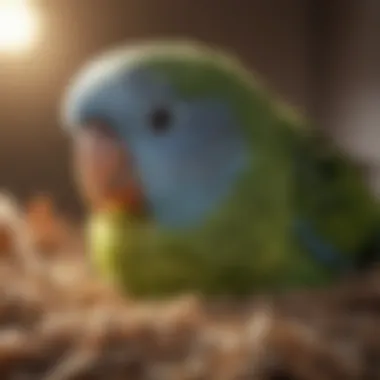
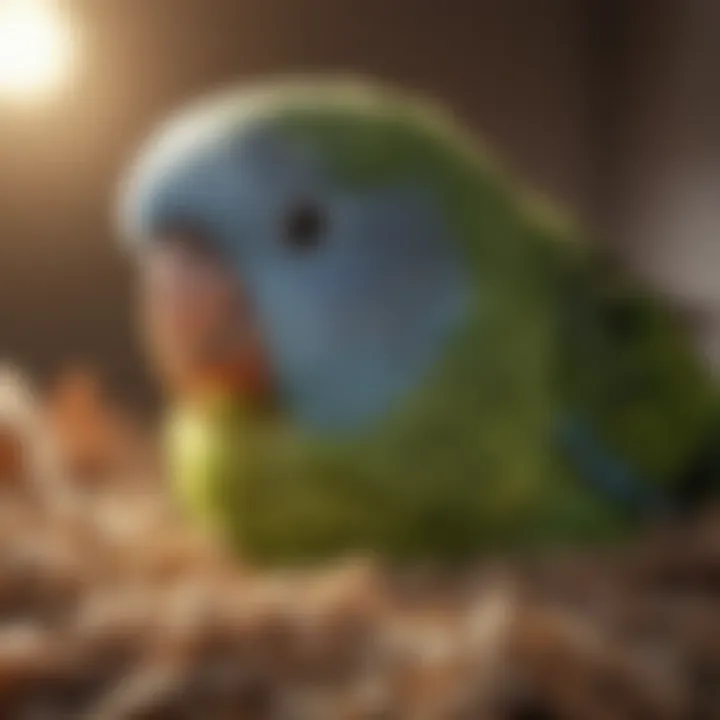
The placement of nesting areas within the aviary is crucial for the comfort and safety of parakeets. A well-placed nesting area can prevent stress and promote positive behaviors. Factors to consider include:
- Accessibility: Ensure that the nesting spot is easily reachable for the birds, offering privacy while still allowing for easy monitoring.
- Avoiding Disturbance: Place nesting materials away from high-traffic areas of the aviary to minimize disruptions from both other birds and people.
- Protection from Predators: If outside, ensure that the nest is safeguarded from potential threats, including larger birds or other animals.
Optimal placement fosters a sense of safety, crucial for successful breeding and nurturing of chicks.
In summary, understanding the impact of environmental factors is integral to providing the best nesting conditions for parakeets, ensuring their health, comfort, and successful breeding.
Behavioral Aspects
Understanding the behavioral aspects of parakeets is essential for providing optimal nesting conditions. Parakeets are social and intelligent birds, and their behaviors around nesting can significantly affect their health and well-being. The nesting period is a critical time, as it directly influences their breeding success and overall happiness. It is important for pet owners to recognize these behaviors and to understand how nestling materials play into them.
Nesting Habits of Parakeets
Parakeets typically exhibit strong nesting instincts, stemming from their wild ancestors. In nature, they seek out various materials to create secure nests. This process is not purely instinctual; it is also influenced by their environment and experiences. The nesting habits can vary by species, but some common behaviors include:
- Material Gathering: Many parakeets enjoy collecting nesting materials from their surroundings. They often pull out pieces of grass, feathers, or other soft items from their living space.
- Building and Arranging: Once they have gathered materials, parakeets start arranging them in their chosen nesting area. This behavior is crucial because it allows them to tailor the nest to their preferences, which can lead to increased comfort.
- Caring for Offspring: After the eggs are laid, the parental behaviors become more prominent. The nest structure’s quality can influence the nesting success. An optimal environment encourages proper incubation and protection of the chicks.
Understanding these habits helps pet owners create the best possible conditions for parakeets. Recognizing that these behaviors stem from natural instincts can further guide how to provide suitable nesting materials.
Interacting with Nesting Materials
Parakeets do not just use nesting materials; they also interact with them in various ways. This interaction is part of their natural behavior and benefits their mental health. Here are some key aspects of how parakeets interact with nesting materials:
- Exploratory Behavior: Parakeets are curious birds. They often investigate new materials, exhibiting behaviors like chewing, tugging, or rearranging items within their space. This exploration can stimulate their minds and prevent boredom.
- Social Interaction: In multi-bird households, nesting material interaction can become social as well. Parakeets may share or compete for preferred items, leading to social bonding or hierarchy establishment among them.
- Stress Relief: Manipulating nesting materials can also serve as a form of stress relief for parakeets. Engaging in this behavior may help alleviate anxiety, making it essential for their well-being.
Providing varied nesting materials can enrich their environment and promote natural behaviors. Owners should observe their birds and adapt choices accordingly to foster these interactions effectively.
"Creating an enriching environment is just as important as selecting the right nesting materials for your parakeets."
Common Mistakes to Avoid
When it comes to providing the best nesting environment for parakeets, ensuring that common mistakes are avoided is crucial. Pet owners often unknowingly create issues that can affect the comfort, health, and breeding behavior of their birds. Understanding these mistakes not only enhances their living conditions but also promotes responsible pet care.
Overcrowded Nesting Spaces
One of the most common errors made by bird owners is overcrowding the nesting space. Parakeets need sufficient room to feel secure while nesting. An overcrowded nest can lead to increased stress levels and aggression among birds.
- Space Requirements: Each parakeet requires its own space within the nest. If they are cramped, it can hinder their natural nesting instincts.
- Hygiene Concerns: More birds in a confined space can lead to waste buildup. This can foster bacteria and mold, posing health risks to the birds.
- Nest Damage: Overcrowded conditions can lead to nesting material being displaced or damaged which can further affect breeding behavior.
To avoid overcrowded nesting spaces, ensure that the nesting spot is spacious enough for the intended number of birds. Regular observation and monitoring can help in maintaining a balanced and healthy environment for your parakeets.
Ignoring Species-Specific Needs
Every species of parakeet has its unique requirements regarding nesting materials and conditions. Ignoring these specific needs can have adverse effects on their health and emotional well-being.
- Material Preference: Some species might prefer softer materials like paper or feathers, while others may opt for more rigid materials such as wood.
- Breeding Seasons: Understanding the breeding behavior of different species allows for the timely provision of nesting materials, which is essential for encouraging breeding.
- Environmental Factors: The needs may also vary according to climate. Species that thrive in wetter environments might require different nesting setups than those from arid regions.
Failure to acknowledge these distinctions not only affects their health but can also lead to failed breeding attempts. Providing the right nest for the right species is a pivotal part of responsible pet ownership.
"Caring for parakeets involves understanding their innate needs and environmental preferences. A tailored approach ensures a harmonious living space."
In summary, avoiding overcrowded nesting spaces and recognizing species-specific requirements are fundamental to the successful care of parakeets. Each small step taken to improve their nesting conditions will contribute to a healthier and more satisfying life for your feathered companions.
End
Understanding the nesting material needs of parakeets is essential for their overall well-being and successful breeding. This article has delved into different types of materials, their pros and cons, preparation methods, and health considerations. The importance of selecting the right nesting material cannot be overstated. Choosing suitable options supports the natural behavior of these birds and contributes to their physical health.
In the context of parakeet care, the conclusion serves to reinforce the critical idea that attentive owners can significantly enhance their pet's living conditions. By ensuring that nests are properly equipped with the right materials, owners can facilitate a comfortable atmosphere for their parakeets to breed, thereby impacting their happiness and longevity positively. Moreover, reliable nesting practices can help prevent stress-related issues and promote better social interactions among parakeets.
Summary of Key Points
- Selecting appropriate nesting materials is crucial.
- Each type of material comes with its own advantages and drawbacks.
- Health considerations, such as avoiding toxins and preventing mold, are vital.
- Proper preparation and arrangement of nesting areas enhance breeding success.
- Understanding specific species' needs can lead to healthier and happier parakeets.
Encouragement for Responsible Pet Care
As a parakeet owner, it is your responsibility to create an optimal living environment. Engage in regular checks of nesting materials, ensuring they are clean and suitable. Research specific species’ requirements and adjust nesting setups as needed. Remember, well-cared-for parakeets not only thrive in their environment but also exhibit healthier behaviors and interactions. By applying the insights gained from this article, pet owners can make informed choices that promote responsible pet care, leading to a more enriching experience for both the birds and their human companions.







